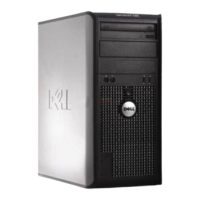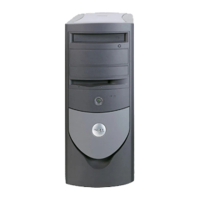310 Glossary
www.dell.com | support.dell.com
rotations that occur per minute. Hard drive speed is often
measured in rpm.
RTC — real time clock — Battery-powered clock on the
system board that keeps the date and time after you shut
down the computer.
RTCRST — real-time clock reset — A jumper on the
system board of some computers that can often be used for
troubleshooting problems.
S
SCANDISK — A Microsoft utility that checks files,
folders, and the hard disk’s surface for errors. ScanDisk
often runs when you restart the computer after it has stopped
responding.
SDRAM — synchronous dynamic random-access
memory — A type of DRAM that is synchronized with the
optimal clock speed of the processor.
SERIAL CONNECTOR — An I/O port often used to
connect devices such as a handheld digital device or digital
camera to your computer.
S
ERVICE TAG — A bar code label on your computer that
identifies your computer when you access Dell Support at
support.dell.com or when you call Dell for customer
service or technical support.
SETUP PROGRAM — A program that is used to install
and configure hardware and software. The setup.exe or
install.exe program comes with most Windows software
packages. Setup program differs from system setup.
SHORTCUT — An icon that provides quick access to
frequently used programs, files, folders, and drives. When
you place a shortcut on your Windows desktop and double-
click the icon, you can open its corresponding folder or file
without having to find it first. Shortcut icons do not change
the location of files. If you delete a shortcut, the original file
is not affected. Also, you can rename a shortcut icon.
SHUTDOWN — The process of closing windows and
exiting programs, exiting the operating system, and turning
off your computer. You can lose data if you turn off your
computer before completing a shutdown.
SMART CARD — A card that is embedded with a
processor and a memory chip. Smart cards can be used to
authenticate a user on computers equipped for smart cards.
SOFTWARE — Anything that can be stored electronically,
such as computer files or programs.
S/PDIF — Sony/Philips Digital Interface — An audio
transfer file format that allows the transfer of audio from
one file to another without converting it to and from an
analog format, which could degrade the quality of the file.
STANDBY MODE — A power management mode that
shuts down all unnecessary computer operations to save
energy.
SURGE PROTECTORS — Prevent voltage spikes, such as
those that may occur during an electrical storm, from
entering the computer through the electrical outlet. Surge
protectors do not protect against lightning strikes or against
brownouts, which occur when the voltage drops more than
20 percent below the normal AC-line voltage level.
Network connections cannot be protected by surge
protectors. Always disconnect the network cable from the
network connector during electrical storms.
SVGA — super-video graphics array — A video standard
for video cards and controllers. Typical SVGA resolutions
are 800 x 600 and 1024 x 768.
The number of colors and resolution that a program displays
depends on the capabilities of the monitor, the video
controller and its drivers, and the amount of video memory
installed in the computer.
S-
VIDEO TV-OUT — A connector used to attach a TV or
digital audio device to the computer.
SXGA — super-extended graphics array — A video
standard for video cards and controllers that supports
resolutions up to 1280 x 1024.
SXGA+ — super-extended graphics array plus — A
video standard for video cards and controllers that supports
resolutions up to 1400 x 1050.
SYSTEM BOARD — The main circuit board in your
computer. Also known as the motherboard.
SYSTEM SETUP — A utility that serves as an interface
between the computer hardware and the operating system.
System setup allows you to configure user-selectable
options in the BIOS, such as date and time or system

